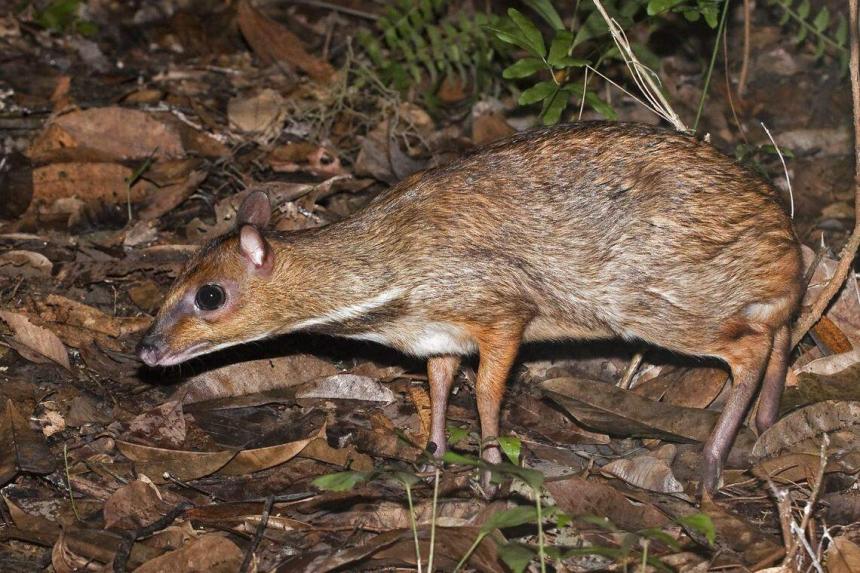SINGAPORE – Over 200 years, Singapore lost most of its original forest and many of the inhabitants within.
The Straits Times looks at key chapters of the island’s natural history and the animals that disappeared during its development, some of which have been spotted again years later.
How Singapore lost its forests
Primeval stage

Most of Singapore is covered by rich, pristine forest. Wildlife is broadly similar to that in southern Peninsular Malaya. Human occupation before the British founded modern Singapore in 1819 is thought to be restricted to some settlements within key estuaries like the Kallang River and Malay fishing villages along the shoreline.

19th century

The first wave of extinctions occurs when swathes of forest are cleared for logging and agriculture, including gambier and pepper plantations. Native plants and insects are the hardest hit by deforestation. Many of these plant species are found only in certain areas, and when they are removed, insect species that depend on them die out.
In 1884, the British create Singapore’s first few forest reserves, including today’s Bukit Timah Nature Reserve, to tackle deforestation.

Early 20th century

A second wave of extinctions is wrought by the felling of regenerated forests for rubber cultivation. This impacts mainly larger animals.
Much of the forest of today’s Bukit Timah Nature Reserve remains intact because of legal protection. Forests in today’s Central Catchment Nature Reserve are also recovering as the area is protected as a water catchment.

Middle to late 20th century

More species of fauna decline with post-independence industrialisation. Large tracts of agricultural land are rapidly repurposed for urban uses like public housing and industry. Butterflies and some birds are especially affected by the tree clearance. Extinctions eventually taper off by the late 20th century.
Only 4.3 per cent of Singapore’s land area today is covered by primary forest and older secondary forest that can support a diverse ecosystem of native species.

Native fauna lost
Blood python (Python brongersmai)

Despite its name, the non-venomous reptile can come in shades varying from yellow to brown. Much of what we know about the snake in Singapore is gleaned from only nine specimens collected before 1908. It can measure up to 1.4m and weigh up to nearly 4kg. The reptile can still be found in Indonesia, Thailand and Malaysia.
Green dragontail butterfly (Lamproptera meges virescens)

The butterfly with transparent wings was usually found near forest streams, a rare habitat in urban Singapore. It most likely went extinct with the loss of the Illigera trifoliata vine that its caterpillars feed on, said ecologist Anuj Jain. The butterfly was last seen before 1926. It can still be found in Malaysia.
Malayan tiger (Panthera tigris jacksoni)

The Malayan tiger, one of the world’s smallest tigers, once prowled the rainforests of Singapore. As forests were cut down for plantations in the 19th century, tiger attacks became increasingly common. The killing of these tigers was encouraged, and the last wild tiger here was killed in 1930 in Choa Chu Kang, nearly a century after the first newspaper report of a tiger. Today, it is estimated that only a few hundred of them remain in the wild globally.
Garnet pitta (Pitta granatina coccinea)

The shy bird with a red crown was last recorded by naturalist Carl Alexander Gibson-Hill in 1949. It thrives in swampy lowland forests, a habitat type that is now very rare in Singapore. The bird is extremely territorial. Its diet is a mix of insects and plant matter. All observations following Dr Gibson-Hill’s sighting are considered erroneous owing to the lack of photographic evidence. Globally, the bird is near-threatened.
Red giant flying squirrel (Petaurista petaurista)

The squirrel was common in Changi during the earlier part of the 20th century. As its name suggests, it travels by gliding from tree to tree. The nocturnal animal can grow up to about half a metre in height, and its tail extends to up to 60cm long. It lives in holes of lofty trees and survives on fruit, leaves and shoots. It was last seen in Singapore in the Central Catchment Nature Reserve in 1986. It is unclear why it is now extinct here, but it can still be found in other parts of Asia, like Thailand and Pakistan.
Half-banded kuhli loach (Pangio semicincta)

The omnivorous freshwater fish once swam in the north and west of Seletar Reservoir. It can grow up to 10cm long. The fish is most often found in calm, shallow, blackwater areas like streams and swamps. It is unclear when exactly the fish went extinct, as samples were collected from the 1930s to the 1950s.
Orange-and-black stingless bee (Tetragonula atripes)

The loss of these bees is troubling because they provide forests with the key ecosystem service of pollination, says entomologist John Ascher, one of the world’s leading bee specialists. A lot of these bees need extensive dipterocarp forests for their nests and foraging. The Dipterocarpaceae family consists of tropical hardwood trees like the chengal tree. The bee was last recorded in Bukit Timah in 1965.
Native fauna found
Greater mousedeer (Tragulus napu)

The animal is neither mouse nor deer. It is one of the world’s smallest hoofed mammals. Owing to the lack of specimens and recorded sightings since 1921, the greater mousedeer was once thought extinct here, unlike its frequently spotted relative, the lesser mousedeer. That changed in 2009, when observation studies on Pulau Ubin confirmed a breeding population there.
Possible factors for the secretive species’ survival include the closure of granite quarries on the island and the resettlement of many villagers thereafter, which increased habitat and vegetation for the mammal to feed on.
Selangor mud snake (Raclitia indica)

The reptile was spotted swimming in a concrete drain near Nee Soon Swamp Forest in 2020, after not being seen for 106 years. The only other record of the snake was at a rubber plantation at Bukit Sembawang in 1914. Regionally, the aquatic species typically found in forest streams is also quite rare, with colour photographs having been published in a research paper only in 2018.
Beaked cloak-and-dagger bee (Thyreus abdominalis rostratus)

The bright-blue bee had not been collected for 95 years until it was trapped at Nee Soon Swamp Forest in 2015. It behaves like a cuckoo bird by laying its eggs in the nests of other bee species. It is believed to target the nest of the island forest-digger bee (Amegilla insularis), a large orange-haired bee mainly restricted to mature forests, said Dr Ascher.
Oriental pied hornbill (Anthracoceros albirostris)

The return of the raucous bird is one of Singapore’s repopulation success stories. The last of three hornbill species native to Singapore was thought to have vanished in the mid-19th century, due to hunting and the loss of suitable habitat. In 1994, a pair was sighted in Pulau Ubin, spelling hope for the species’ revival. Artificial nest boxes were set up by researchers to boost breeding. In 2008, a pair of captive-bred hornbills were also taken to a site in Bukit Timah, the first time this was done on mainland Singapore.
Today, the adaptable omnivorous bird is a fairly common sight in urban areas. It plays a crucial role in the spread and germination of seeds from big-fruited forest trees.
White-tipped baron butterfly (Euthalia merta)

The butterfly is often mistaken for other baron butterflies, according to Dr Jain. Both sexes from this species have a luminescent bluish sheen on their forewings. The species was rediscovered in the early 2000s. It is listed as nationally endangered.


